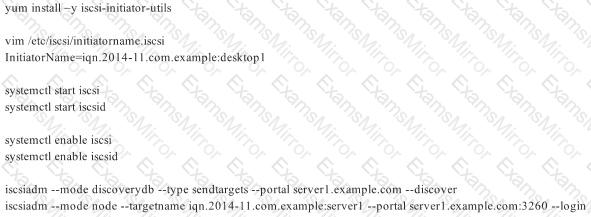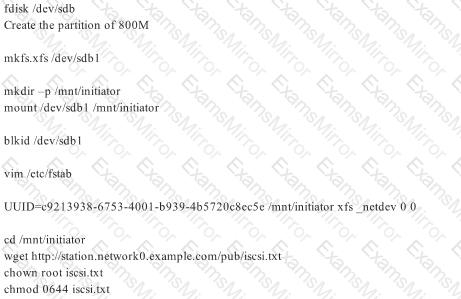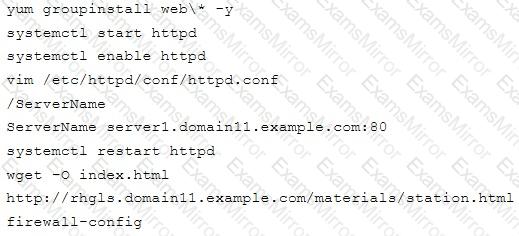Cyber Monday Special Limited Time 70% Discount Offer - Ends in 0d 00h 00m 00s - Coupon code = getmirror
Pass the RedHat RHCE EX300 Questions and answers with ExamsMirror
Exam EX300 Premium Access
View all detail and faqs for the EX300 exam
556 Students Passed
93% Average Score
98% Same Questions
There were two systems:
system1, main system on which most of the configuration take place
system2, some configuration here
SMTP Configuration.
Configure the SMTP mail service on serverX and desktopX which relay the mail only from local system through station.network0.example.com, all outgoing mail have their sender domain as example.com. Ensure that mail should not store locally.
Verify the mail server is working by sending mail to a natasha user.
Check the mail on both serverX and desktopX with the below URL
http://station.network0.example.com/system1
http://station.network0.example.com/system2
There were two systems:
system1, main system on which most of the configuration take place
system2, some configuration here
Virtual hosting.
Setup a virtual host with an alternate document root.
Extend your web to include a virtual for the site vhostsX.example.com">http://vhostsX.example.com
Set the document root as /usr/local/vhosts
Download station.network0.example.com/pub/rhce/vhost/html">http://station.network0.example.com/pub/rhce/vhost/html
Rename it as index.html
Place this document root of the virtual host
Note: the other websites configures for your server must still accessible. vhosts.networkX.example.com is already provided by the name server on example.com
There were two systems:
system1, main system on which most of the configuration take place
system2, some configuration here
Configure SCSI storage.
Create a new 1 GB target on your serverX.example.com
The block device name should be data_block
The server should export an iscsi disk called iqn.2014-10.com.example:serverX
This target should only be allowed to desktop
.
There were two systems:
system1, main system on which most of the configuration take place
system2, some configuration here
Configure repository.
Create a Repository for your virtual machines. The URL is http://station.network.0.example.com/content/rhel7.0/x86_64/dvd
There were two systems:
system1, main system on which most of the configuration take place
system2, some configuration here
Script2.
Create a script on serverX called /root/createusers
When this script is called with the argument, it should add all the users from the file
Download the file from station.network0.example.c">http://station.network0.example.com/pub/testfile
All users should have the login shell as /bin/false, password not required
When this script is called with any other argument, it should print the message as “Input File Not Found”
When this script is run without any argument, it should display “Usage:/root/createusers”
NOTE: if the users are added no need to delete
There were two systems:
system1, main system on which most of the configuration take place
system2, some configuration here
Webserver.
Implement a webserver for the site http://server X.example.com
Download the webpage from http://station.network0.example.com/pub/rhce/rhce.html
Rename the downloaded file in to index.html
Copy the file into the document root
Do not make any modification with the content of the index.html
Clients within my22ilt.org should NOT access the webserver on your systems
There were two systems:
system1, main system on which most of the configuration take place
system2, some configuration here
iSCSI Initiator
The serverX.example.com provides an iscsi port (3260). Connect the disk with desktopX.example.com and configure filesystem with the following requirements.
Create 800 MB partition on iSCSI block device and assign the filesystem as xfs
Mount the volume under /mnt/initiator at the system boot time
The filesystem should contain the copy of http://station.network0.example.com/pub/iscsi.txt
The file should be owned by root with 0644 permission
NOTE: the content of the file should not be modified
RHCE Test Configuration Instructions
Information for the two systems you will use in test is the following:
system1.group3.example.com: is one of the main sever. system2.group3.example.com: mainly used as a client.
Password for both of the two systems is atenorth
System’s IP is provided by DHCP, you can regard it as normal, or you can reset to Static IP in accordance with the following requirements:
system1.group3.example.com: 172.24.3.5
system2.group3.example.com: 172.24.3.10
The subnet mask is 255.255.255.0
Your system is a member of DNS domain group3.example.com. All systems in DNS domain group3.example.com are all in subnet 172.24.3.0/255.255.255.0, the same all systems in this subnet are also in group3.example.com, unless specialized, all network services required to be configured can be accessed by systems of domain group3.
host.group3.example.com provides a centralized authentication service domain
GROUP3.EXAMPLE.COM, both system1 and system2 have already been pre-configured to be the client for this domain, this domain provides the following user account:

Firewall is enabled by default, you can turn it off when deemed appropriate, other settings about firewall may be in separate requirements.
Your system will be restarted before scoring, so please ensure that all modifications and service configurations you made still can be operated after the restart without manual intervention, virtual machine instances of all examinations must be able to enter the correct multi-user level after restart without manual assistance, it will be scored zero if the test using virtual machine system cannot be restarted or be properly restarted.
Corresponding distribution packages for the testing using operating system Red Hat Enterprise Linux version can be found in the following link:
http://server1.group3.example.com/rhel
Part of the requirements include host security, ensure your host security limit does not prevent the request to allow the host and network, although you correctly configured the network service but would have to allow the host or network is blocked, this also does not score.
You will notice that some requirements which clearly do not allow services be accessed by service domain my133t.org, systems of this domain are in subnet 172.25.1.0/252.255.255.0, and systems of these subnets also belong to my 133t.org domain.
PS: Notice that some test questions may depend on other exam questions, for example, you might be asked to perform a series of restrictions on a user, but this user creation may be required in other questions. For convenient identification, each exam question has some radio buttons to help you identify which questions you have already completed or not completed. Certainly, you do not need to care these buttons if you don’t need them.
Dynamic WEB content
Configure dynamic web content to provide on the system1, as required:
Dynamic content provided by a virtual machine named dynamic.domain11.example.com
Virtual host listening on port 8909
Download a script from http://rhgls .domain11.example.com/materials/webapp.wsgi, then put it in the right place, don’t modify the file content in any situations
Dynamically generated web page should be received when clients access http://dynamic.domain11example.com:8909.
This http:// dynamic.domain11.example.com:8909/ must be able to be accessed by all system of domain11.example.com
RHCE Test Configuration Instructions
Information for the two systems you will use in test is the following:
system1.group3.example.com: is one of the main sever. system2.group3.example.com: mainly used as a client.
Password for both of the two systems is atenorth
System’s IP is provided by DHCP, you can regard it as normal, or you can reset to Static IP in accordance with the following requirements:
system1.group3.example.com: 172.24.3.5
system2.group3.example.com: 172.24.3.10
The subnet mask is 255.255.255.0
Your system is a member of DNS domain group3.example.com. All systems in DNS domain group3.example.com are all in subnet 172.24.3.0/255.255.255.0, the same all systems in this subnet are also in group3.example.com, unless specialized, all network services required to be configured can be accessed by systems of domain group3.
host.group3.example.com provides a centralized authentication service domain
GROUP3.EXAMPLE.COM, both system1 and system2 have already been pre-configured to be the client for this domain, this domain provides the following user account:

Firewall is enabled by default, you can turn it off when deemed appropriate, other settings about firewall may be in separate requirements.
Your system will be restarted before scoring, so please ensure that all modifications and service configurations you made still can be operated after the restart without manual intervention, virtual machine instances of all examinations must be able to enter the correct multi-user level after restart without manual assistance, it will be scored zero if the test using virtual machine system cannot be restarted or be properly restarted.
Corresponding distribution packages for the testing using operating system Red Hat Enterprise Linux version can be found in the following link:
http://server1.group3.example.com/rhel
Part of the requirements include host security, ensure your host security limit does not prevent the request to allow the host and network, although you correctly configured the network service but would have to allow the host or network is blocked, this also does not score.
You will notice that some requirements which clearly do not allow services be accessed by service domain my133t.org, systems of this domain are in subnet 172.25.1.0/252.255.255.0, and systems of these subnets also belong to my 133t.org domain.
PS: Notice that some test questions may depend on other exam questions, for example, you might be asked to perform a series of restrictions on a user, but this user creation may be required in other questions. For convenient identification, each exam question has some radio buttons to help you identify which questions you have already completed or not completed. Certainly, you do not need to care these buttons if you don’t need them.
Database Query
Use database Contacts on the system1, and use the corresponding SQL to search and answer the following questions:
What’s the person name whose password is solicitous?
How many people’s names are John and live is Shanghai at the same time?
RHCE Test Configuration Instructions
Information for the two systems you will use in test is the following:
system1.group3.example.com: is one of the main sever. system2.group3.example.com: mainly used as a client.
Password for both of the two systems is atenorth
System’s IP is provided by DHCP, you can regard it as normal, or you can reset to Static IP in accordance with the following requirements:
system1.group3.example.com: 172.24.3.5
system2.group3.example.com: 172.24.3.10
The subnet mask is 255.255.255.0
Your system is a member of DNS domain group3.example.com. All systems in DNS domain group3.example.com are all in subnet 172.24.3.0/255.255.255.0, the same all systems in this subnet are also in group3.example.com, unless specialized, all network services required to be configured can be accessed by systems of domain group3.
host.group3.example.com provides a centralized authentication service domain
GROUP3.EXAMPLE.COM, both system1 and system2 have already been pre-configured to be the client for this domain, this domain provides the following user account:

Firewall is enabled by default, you can turn it off when deemed appropriate, other settings about firewall may be in separate requirements.
Your system will be restarted before scoring, so please ensure that all modifications and service configurations you made still can be operated after the restart without manual intervention, virtual machine instances of all examinations must be able to enter the correct multi-user level after restart without manual assistance, it will be scored zero if the test using virtual machine system cannot be restarted or be properly restarted.
Corresponding distribution packages for the testing using operating system Red Hat Enterprise Linux version can be found in the following link:
http://server1.group3.example.com/rhel
Part of the requirements include host security, ensure your host security limit does not prevent the request to allow the host and network, although you correctly configured the network service but would have to allow the host or network is blocked, this also does not score.
You will notice that some requirements which clearly do not allow services be accessed by service domain my133t.org, systems of this domain are in subnet 172.25.1.0/252.255.255.0, and systems of these subnets also belong to my 133t.org domain.
PS: Notice that some test questions may depend on other exam questions, for example, you might be asked to perform a series of restrictions on a user, but this user creation may be required in other questions. For convenient identification, each exam question has some radio buttons to help you identify which questions you have already completed or not completed. Certainly, you do not need to care these buttons if you don’t need them.
Implement/configure a Web Service.
Configure a site http://systeml. domain11.example.com/ on the system1, then execute the following steps:
(1) Download file from http://rhgls.domain11.example.com/materials/station.html and rename this files index.html, don’t modify the file contents;
(2) Copy the file index.html to your web server's DocumentRoot directory
(3) Clients from domain group3.example.com can access to this web service
(4) Clients from domain my133t.org deny access to this web service
TOP CODES
Top selling exam codes in the certification world, popular, in demand and updated to help you pass on the first try.








